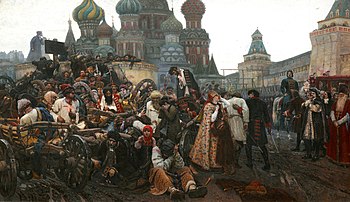Streltsy uprising
The Streltsy Uprising of 1698 (Russian: Стрелецкое восстание) was an uprising of the Moscow Streltsy regiments.

Some Russian historians believe that the Streltsy uprising was a reactionary rebellion against progressive innovations of Peter the Great. Others suggest that it was a riot against the yoke of the serfdom oppression, military service hardships and harassment.
The Moscow Streltsy, which had participated in Peter the Great's Azov campaigns in 1695–1696, were left in Azov as a garrison. In 1697, however, the four regiments of Streltsy were unexpectedly sent to Velikiye Luki instead of Moscow. On their way there, they were starving and carrying their ordnance by themselves due to absence of horses. In March of 1698, 175 Streltsy left their regiments and fled to Moscow to file a complaint. They secretly established contact with Sophia Alekseyevna, who had been incarcerated at the Novodevichy Monastery, and hoped for her mediation. The runaway Streltsy, despite their resistance, were sent back to their regiments, giving rise to discontent among the rest of them.
On June 6, Streltsy removed their commanding officers, chose four electives from each regiment (see Streltsy), and made their way to Moscow, getting ready to punish the boyars and foreign advisers and blaming them for all adversities. The rebels (approx. 4,000 men) intended to install Sophia or, in case of her refusal, her alleged lover Vasili Golitsyn, who had been in exile. Peter I ordered four regiments (2,300 men) and a cavalry unit under the command of Aleksey Shein and Patrick Gordon to attack the Streltsy. On June 18, the Streltsy were defeated not far from the New Jerusalem Monastery (Voskresensky Monastery) 40 km west of Moscow.
As a result of a major investigation, 57 Streltsy were executed and the rest sent into exile. Upon his return from abroad on August 25, 1698, Peter I ordered another investigation. Between September of 1698 and February of 1699, 1182 Streltsy were executed, 601 of them were whipped, branded with iron, or sent into exile (mostly, the young ones). The investigation and executions continued up until 1707. The Moscow regiments, which had not participated in the uprising, were later disbanded. Streltsy and their family members were removed from Moscow.
Literature
Alexander Moutchnik: Der "Strelitzen-Aufstand" von 1698, in: Volksaufstände in Russland. Von der Zeit der Wirren bis zur "Grünen Revolution" gegen die Sowjetherrschaft, hrsg. von Heinz-Dietrich Löwe. Forschungen zur osteuropäischen Geschichte, Bd. 65, Harrassowitz Verlag, Wiesbaden, 2006, S. 163–196. ISBN 3-447-05292-9 (The Streltsy Uprising of 1698)
